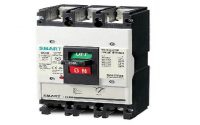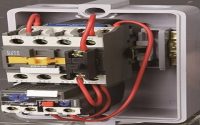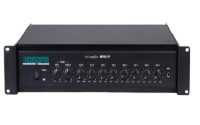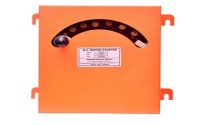What is Gas Insulated Switchgear & Its Working
Switchgear is a combination of fuses, switches, and circuit breakers in an electric power system. The main function of switchgear is to protect, isolate and control electrical devices. The connection of this can be done directly to the consistency of the power supply. In the 19th century, high voltage switchgear was invented which is used for operating electric machines as well as motors. In substations, switchgear is placed on both sides of the voltages of the power transformers. In industries, the arrangement of switchgear, as well as a transformer, may be united in one housing which is known as USS or unitized substation. Based on the present research through Visiongain, the switchgear market worldwide can be estimated to attain $152.5 billion up to the year2029. This article discusses an overview of gas-insulated switchgear.
What is Gas Insulated Switchgear?
Definition: The GIS or Gas-insulated high-voltage switchgear (GIS) is a solid metal encapsulated device that includes different high-voltage components like disconnectors as well as circuit-breakers. These devices can be operated very securely in restricted areas like limited spaces. For instance, it is used in the extension of city buildings, on offshore platforms, on roofs, and indifferent plants like industrial as well as hydropower.
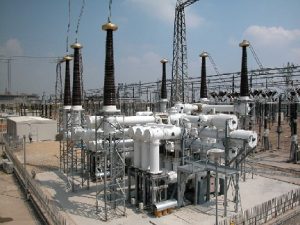
In this type of switchgear, all the components of this can be brought together in an extremely restricted area by enclosing through the gas-tight metal area as well as SF6 gas can be used as insulation among existing parts of the devices & earthed metal enclosure. This kind of switchgear is accessible from 12 KV- 800 KV systems. The insulated switchgear like SF6 plays a key role in establishing an electrical substation in a restricted area.
Components
The Gas-insulated switchgear design can be done using different components like circuit breakers, bus bars, disconnectors or isolators, transformers like voltage and current, earth switches, lightning arresters, and surge arrestors. When the substation is connected with gas-insulated switchgear then it is called GIMES or gas-insulated metal-enclosed substation. This kind of technology is not invented recently but it is available for the past 30 years.
In gas-insulated medium-voltage switchgear, SF6 gas works like an insulation material whereas the vacuum technology is mainly used for the purpose of interrupting. Even though, for both insulation and interruption, the SF6 gas can be used in several medium voltage gas insulated switchgear systems.
However, for such devices, SF6 gas pressures are dissimilar for insulation as well as an interruption. For insulating, this gas pressure is usually kept under 2.5 bar, whereas for interrupting, it is ranged from 5 – 7 bar.
Gas Insulated Switchgear Vs Air Insulated Switchgear
The difference between gas-insulated switchgear and air-insulated switchgear is discussed below.
| Air Insulated Switchgear (AIS) | Gas Insulated Switchgear (GIS) |
| The design standards of AIS are IEC like. IEC 62271-1, IEC 62271-100, IEC 62271-200,etc | The design standards of GIS are IEC like. IEC 62271-1, IEC 62271-100, IEC 62271-200,etc |
| For busbar insulation in AIS, air media is used. | For busbar insulation in GIS, SF6 media is used. |
| For Switching, the media used in AIS is Oil, Air, Vacuum or SF6 | For Switching, the media used in GIS is Vacuum or SF6 |
| The execution type through switching devices in AIS is Fixed otherwise draw-out based on the design | The execution type through switching devices in GIS is Fixed |
| The physical size of AIS is fairly larger because clearances are within Air, so some secure clearances should be maintained for satisfying the performance of dielectric. | The physical size of GIS is fairly smaller |
| In AIS, Sensitivity to surroundings or pollution is moderate | In GIS, sensitivity to surroundings or pollution is excellent |
| The maintenance requirement of AIS is Moderate | The maintenance requirement of GIS is Minimal |
| Cable termination necessities for AIS is not specific because standard types of cable termination can be used | Cable termination necessities for GIS is specific to maintain suitable insulation through reduced air clearances within the compartment of the cable connection |
| Monitoring of gas pressure in AIS might be necessary simply for switching devices by including SF6 gas | Monitoring of gas pressure in GIS might be necessary simply for both switching devices as well as busbars by includingSF6 gas |
Switchgear Testing
In switchgear, the high voltage can cause pressure for the equipment being used. So, testing is essential to overcome many problems. For that, an insulation test is recommended. So, GIS systems need exactly similar tests to other systems. But, they are frequently hard to access, so they need some particular solutions.
The condition of switchgear within buildings can impact the protection of its surroundings. So without normal maintenance as well as testing, CB’s (circuit breakers) can build up troubles by causing arc faults as well as arc flashes to damage properties as well as harm workers.
Circuit breaker tests are mainly performed based on the capacity of voltage within the circuit breaker as well as its mechanism. Here, the tests mainly focus on MV (medium voltage) as well as HV (high voltage) switchgear, despite the mechanism. The switchgear tests will maintain the performance of HV & MV of the circuit breakers like Contact Timing, Travel & Velocity, Functional, Vibration, X-Ray, Contact Resistance, Dynamic Contact Resistance, AC Insulation, Tightness & Insulation Test for Auxiliary Circuits.
Advantages
The advantages of gas-insulated switchgear include the following.
- This switchgear provides high flexibility as well as reliability as compared with other solutions. Because of the gas enclosed design, this kind of switchgear is the best solution for different substations like indoor as well as underground
- By using this switchgear, the occupied area of indoor and outdoor substations can be reduced
- The configurations of this kind of switchgear can be applied to any sort of bus bars like single, double, single with transfer bus, double bus bar including double circuit breaker, and ring type bus bar.
- It occupies less space
- Security against ecological processes
- Free choice for site installation
- Less maintenance
- Less operating cost
- GIS designs are applicable wherever these features are desirable like less maintenance, less space, less impact of surroundings, etc.
Disadvantages
The disadvantages of gas-insulated switchgear include the following.
- As compared with other substations like conventional or air-insulated, these are expensive.
- Once fault happens inside, the outage phase will be extremely long and the effect of damage will also be very severe.
- SF6 gas acquisition, as well as its supply toward the site, is problematic
- Maintenance is very important because the moisture otherwise dust within the compartment can cause the burst
- This kind of substation requires separate buildings because this is an indoor type
- It is expensive as compared with conventional type substation which is used at outdoor
- When an internal fault occurs, it takes more time to repair the damaged part at the substation
- Sufficient gas stock should be maintained.
Gas Insulated Switchgear Applications
The gas-insulated switchgear applications include the following.
- Power transmission
- Railways
- Incorporation of renewable power generation units toward the grid
- These are preferred in large towns because the availability of space in the towns is less
- Valleys as well as mountain regions
- Underground substations
- Substations on sea otherwise lake
- Terminal substations based on HVDC transmission system
- Industrial complexes
Thus, this is all about an overview of Gas Insulated Switchgear. Most of the switchgear can be tested for maintaining purpose based on a bi-annual otherwise tri-annual. The testing program can be determined through the design of switchgear. To observe how frequently a facility’s breakers should be tested, then the manager of the building should call Prime Power. On an emergency basis, switchgear testing is essential and it is usually discovered throughout regular maintenance. But, emergency testing is rarely necessary when switchgear is maintained regularly. Here is a question for you, what are the types of gas-insulated switchgear available in the market.

